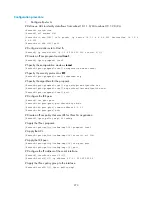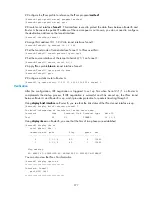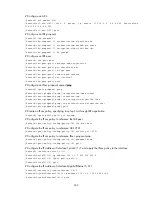
285
# Create IKE peer
peer
.
[RouterB] ike peer peer
# Set the pre-shared key.
[RouterB-ike-peer-peer] pre-shared-key abcde
# Specify the IP address of the peer security gateway.
[RouterB-ike-peer-peer] remote-address 1.1.1.1
[RouterB-ike-peer-peer] quit
# Create an IPsec policy that uses IKE.
[RouterB] ipsec policy use1 10 isakmp
# Reference ACL 3101 to identify the protected traffic.
[RouterB-ipsec-policy-isakmp-use1-10] security acl 3101
# Reference IPsec proposal
tran1
.
[RouterB-ipsec-policy-isakmp-use1-10] proposal tran1
# Reference IKE peer
peer
.
[RouterB-ipsec-policy-isakmp-use1-10] ike-peer peer
[RouterB-ipsec-policy-isakmp-use1-10] quit
# Apply IPsec policy
use1
to interface GigabitEthernet 1/0/1.
[RouterB] interface gigabitethernet 1/0/1
[RouterB-GigabitEthernet1/0/1] ipsec policy use1
3.
Verify the configuration.
# Send traffic from subnet 10.5.5.0/24 to subnet 10.4.4.0/24 or from subnet 10.4.4.0/24 to
10.5.5.0/24. IKE negotiation is triggered to establish IPsec SAs between Router A and Router B.
# Display the routing table on Router A.
[RouterA] display ip routing-table
Routing Tables: Public
Destinations : 8 Routes : 8
Destination/Mask Proto Pre Cost NextHop Interface
1.1.0.0/16 Direct 0 0 1.1.1.1 GE1/0/1
1.1.1.1/32 Direct 0 0 127.0.0.1 InLoop0
2.2.2.0/24 Static 60 0 1.1.1.2 GE1/0/1
10.4.4.0/24 Direct 0 0 10.4.4.1 GE1/0/2
10.4.4.4/32 Direct 0 0 127.0.0.1 InLoop0
10.5.5.0/24 Static 60 0 1.1.1.2 GE1/0/1
127.0.0.0/8 Direct 0 0 127.0.0.1 InLoop0
127.0.0.1/32 Direct 0 0 127.0.0.1 InLoop0
The output shows that IPsec RRI has created a static route to subnet 10.5.5.0/24 with the next hop
1.1.1.2.
# Delete the IPsec SAs. The static route is automatically deleted.
















































